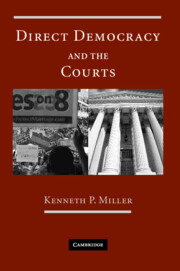Book contents
- Frontmatter
- Contents
- List of Tables and Figures
- Preface
- Introduction: A Clash of Rising Powers
- PART I THE QUEST FOR MAJORITY RULE
- PART II COUNTERING THE MAJORITY
- 3 The Counter-Majoritarian Power
- 4 The Courts at Work
- 5 Conflicts Over Rights
- 6 Conflicts Over Powers
- PART III THE MAJORITY STRIKES BACK
- Conclusion: A New Constitutional Equilibrium
- Appendix: Post-Election Initiative Invalidations
- References
- Index
- References
3 - The Counter-Majoritarian Power
Published online by Cambridge University Press: 05 June 2012
- Frontmatter
- Contents
- List of Tables and Figures
- Preface
- Introduction: A Clash of Rising Powers
- PART I THE QUEST FOR MAJORITY RULE
- PART II COUNTERING THE MAJORITY
- 3 The Counter-Majoritarian Power
- 4 The Courts at Work
- 5 Conflicts Over Rights
- 6 Conflicts Over Powers
- PART III THE MAJORITY STRIKES BACK
- Conclusion: A New Constitutional Equilibrium
- Appendix: Post-Election Initiative Invalidations
- References
- Index
- References
Summary
Direct democracy was grafted into a larger constitutional system defined by checks and balances. Because that system matches power with counter-power, one could expect direct democracy to meet opposition from other branches of government. But, in many states, the reformers specifically designed the initiative process to bypass external checks. The question thus became: Could the Madisonian system effectively limit citizen lawmaking? This chapter examines the capacity of various institutions to counter the initiative power and discusses why courts are best positioned to exercise this check.
POTENTIAL INSTITUTIONAL COUNTER-POWERS
The Legislature
Legislatures see direct democracy as a rival power. This natural animosity makes it all the more surprising that reformers convinced any legislature to devolve lawmaking authority to the people. Following the Progressive Era, legislatures strengthened their resistance to the people's rule. After 1918, only a handful of legislatures offered voters a chance to adopt the initiative process and, in those rare instances, imposed severe restrictions on its use. More often, legislatures sought to limit the initiative power where it already existed. Over time, legislatures have attempted to constrain the initiative power in three primary ways: by enacting laws that impede the people's ability to use the process; by repealing or amending voter-approved initiatives; or, short of repeal, by failing to implement initiatives as their proponents intended.
- Type
- Chapter
- Information
- Direct Democracy and the Courts , pp. 75 - 100Publisher: Cambridge University PressPrint publication year: 2009



